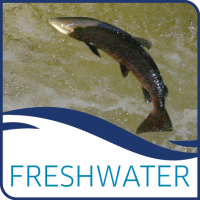The 2020 season catch data are the summations of reports from individual fisheries. No attempt has been made to correct for non-returns or incomplete information held in the register of proprietors and occupiers.
Reported rod catches from the 2020 season are provided at the finest time scale and geographical scale possible, while complying with data protection legislation and the Code of Practice for Statistics. Where possible this is by month and Assessment area, and also by month and Salmon Fishery District. Catch data by Assessment area and District are not included where there are insufficient returns to provide anonymity of data relating to a living individual. Reporting area and regional catch data are available within the time series: Salmon and Sea Trout fishery statistics: 1952 - 2020 - reported catch and effort by method.
Reported net catches from the 2020 season are provided at the finest time scale and geographical scale possible, while complying with data protection legislation and the Code of Practice for Statistics. Where possible this is by month and Salmon Fishery District. Catch data by District are not included where there are insufficient returns to provide anonymity of data relating to a living individual. National catch data are available within the time series: “Salmon and Sea Trout fishery statistics: 1952 - 2020 - reported catch and effort by method”.
Assessment Areas are individual rivers, except for those areas where fishery catch cannot be assigned to individual rivers. In such cases, rivers are combined to form geographically-coherent groups of rivers.
Salmon Fishery Districts are defined in legislation and correspond either to a single river catchment together with adjacent coast or to groups of neighbouring river catchments and associated coastline. Districts may be further aggregated into Salmon Fishery Regions whose extents are described in our Topic Sheet publication “Collecting the Marine Scotland Salmon and Sea Trout Fishery Statistics”.
Reporting Areas are Salmon Fishery Districts where possible, but where there are few active rod fisheries the data are aggregated into geographically-coherent groupings of Districts. A list of Assessment Areas with their corresponding Salmon Fishery District, Reporting Area and Salmon Fishery Region is available to download below.
Salmon Fishery Districts are characterised by Name and District Plot Order. Ordering the data with respect to “District Plot Order” sorts the areas spatially. Districts are ordered counter-clockwise starting with the Tweed as Report Order 1.
Finnock, which may also be known as whitling or herling, are sea trout which have spent less than a year at sea and are making their first return to fresh water. They are not included in sea trout numbers.
Topic sheets have been published summarising the 2020 Official Statistics for the time series (1952-2020) for both salmon and sea trout. Time series data are available from Marine Scotland Data and summary data are available from our data visualisation application, accessible from the related content section below.
Data and Resources
| Field | Value |
|---|---|
| Publisher | |
| Modified | 2023-05-17 |
| Release Date | 2021-05-25 |
| Identifier | 185e1c69-7204-4a59-8fbf-5aa9d652dcc1 |
| Spatial / Geographical Coverage Location | Scotland |
| Temporal Coverage | 2020-01-01 to 2020-12-31 |
| License | UK Open Government Licence (OGL) |
| Author | |
| Data Dictionary | Fishery statistics for a given season are usually published in the following April. |
| Contact Name | Marine Scotland |
| Contact Email | |
| Public Access Level | Public |


